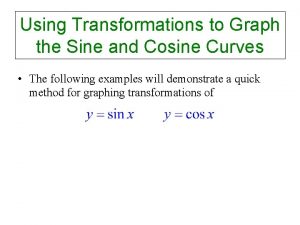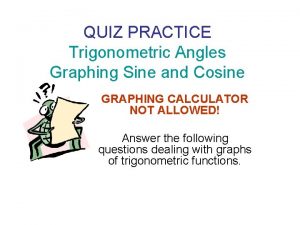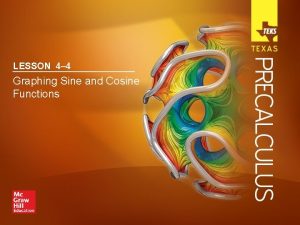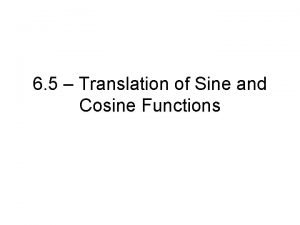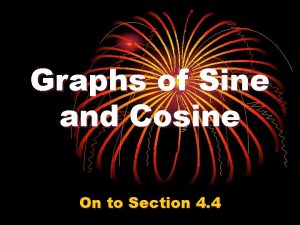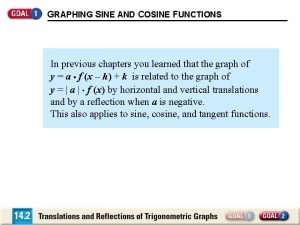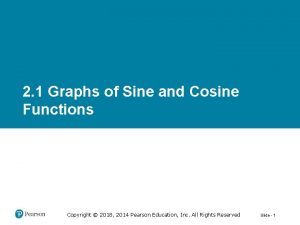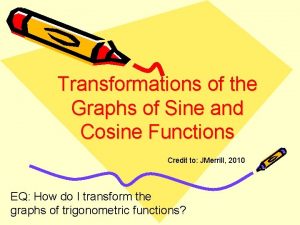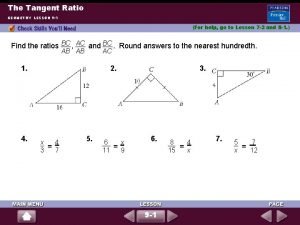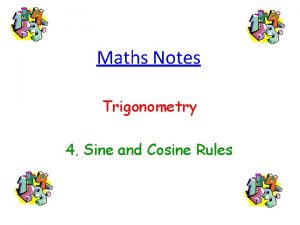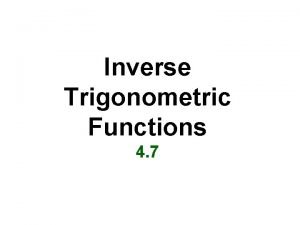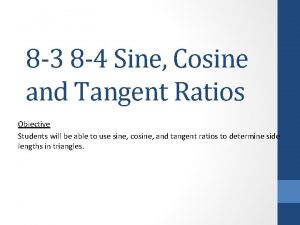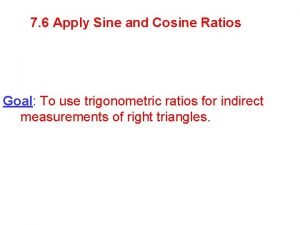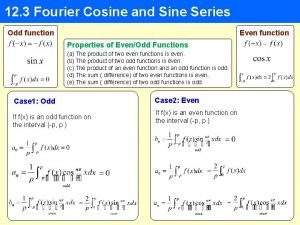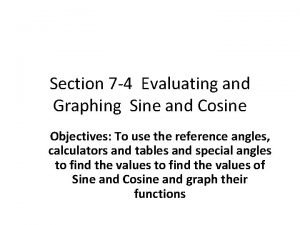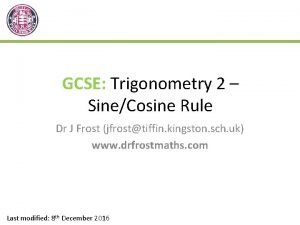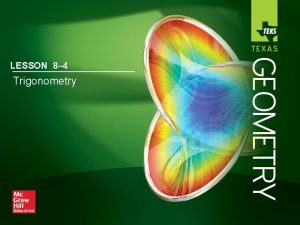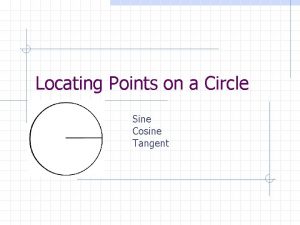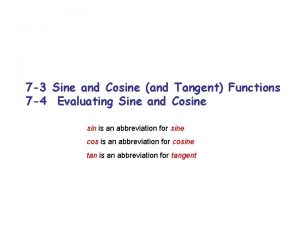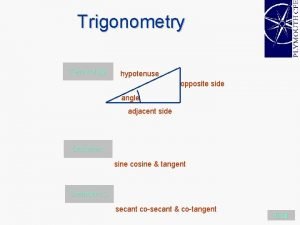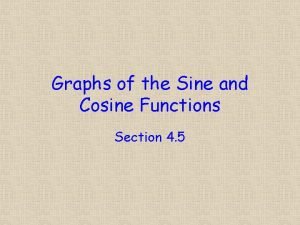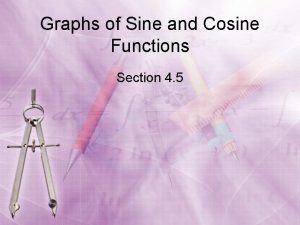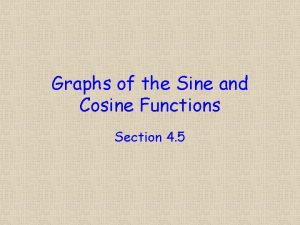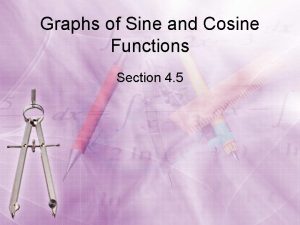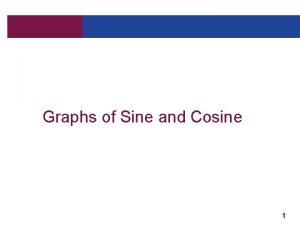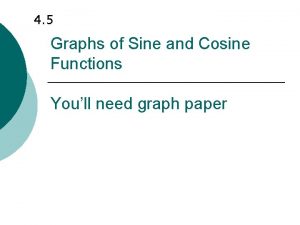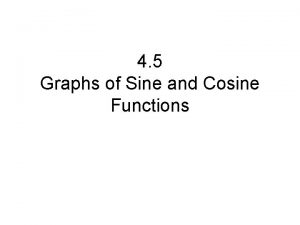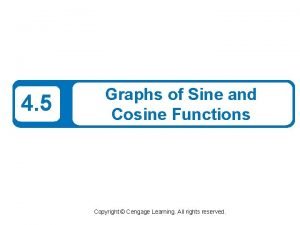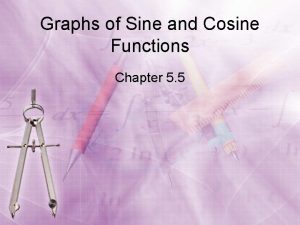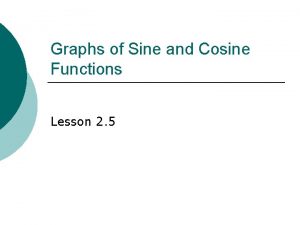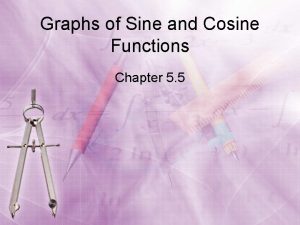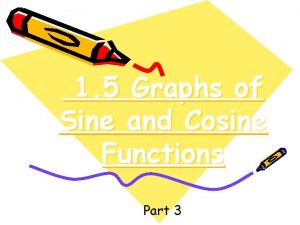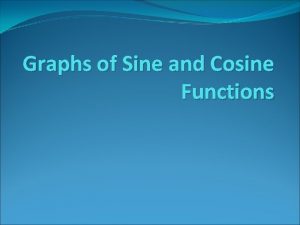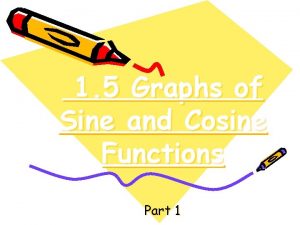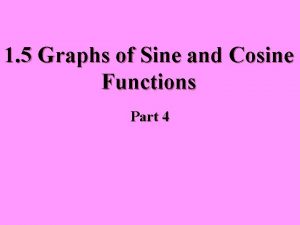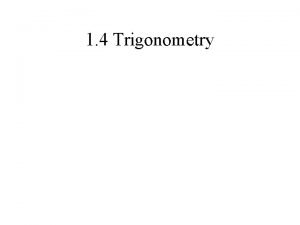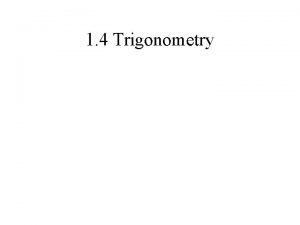Graphs of Sine and Cosine Functions Section 4







































- Slides: 39

Graphs of Sine and Cosine Functions Section 4. 5

Objectives • Sketch the graphs of sine and cosine functions and their variations. • Use amplitude and period to help sketch the graphs of sine and cosine functions. • Sketch translations of graphs of sine and cosine.

http: //www. youtube. com/watch? v=n. Xx 2 Psg. Mj. YA

120° 90° 135° y = sin x 1 – 1 45° 150° 30° 180° 0° 330° 210° 225° 240° 90° 180° 60° 270° 315° 300° 360°

120° 90° 135° 60° 45° 150° y = sin x 30° 180° 0° 330° 210° 225° 240° 90° 180° 270° 315° 300° 360°

Sine starts at the sea shore

Graph of the Sine Function To sketch the graph of y = sin x we don’t need many points, just the key points. These are the maximum points, the minimum points, and the intercepts. x 0 sin x 0 1 0 -1 0 y = sin x y x

Amplitude • Amplitude

Period • Period

Amplitude (the height) The phase shift is a right or left shift of the graph.

§ § § Identify the amplitude and the period. Find the values of x for the five key parts---the x-intercepts (3 for sine), the maximum point, and the minimum point. Divide the period into 4 quarter-periods. Plot the five key points. Connect the key points with a smooth graph and graph one complete cycle. Extend the graph in step 4 to the left or right as desired. (phase shift) y y = 2 sin x x y = sin x y = – 4 sin x reflection of y = 4 sin x

Free Graph Paper for Graphing Trig Functions http: //mathbits. com/Math. Bits/Student. Resources/Graph. Paper. ht m

§ Identify the amplitude and the period. § Find the values of x for the five key parts---the xintercepts (3 for sine), the maximum point, and the minimum point. Divide the period into 4 quarter-periods. § Plot the five key points. § Connect the key points with a smooth graph and graph one complete cycle. § Extend the graph in step 4 to the left or right as desired.



Example: Sketch the graph of y = 2 sin (– 3 x). Rewrite the function in the form y = a sin bx with b > 0 Use the identity sin (– x) = – sin x: y = 2 sin (– 3 x) = – 2 sin 3 x amplitude: |a| = |– 2| = 2 period: 2 = 2 3 Calculate the five key points. x 0 y = – 2 sin 3 x 0 y 0 – 2 2 0 ( , 2) x (0, 0) ( , -2) ( , 0)

y y = A sin Bx Amplitude: | A| x Starting point: x = C/B Period: 2 /B

Maximum height One cycle Starting point to the right

Amp = 2

Amplitude (height) Vertical Shift (Up or down)

y = a sin(bx – c) + d Vertical shift is the amount that the red curve is moved up (or down) compared to the reference (black) curve. A positive shift means an upward displacement while a negative shift means a downward displacement. vertical shift This black curve is for reference.

§ § § Identify the amplitude and the period, the phase shift, and the vertical shift. Find the values of x for the five key parts---the xintercepts (3 for sine), the maximum point, and the minimum point. Divide the period into 4 quarterperiods. Find and plot the five key points. Connect the key points with a smooth graph and graph one complete cycle. Extend the graph in step 4 to the left or right and up or down as desired Graph of Sine Applet


Example 1: Sketch the graph of y = sin (–x). The graph of y = sin (–x) is the graph of y = sin x reflected in the x-axis. y Use the identity sin (–x) = – sin x y = sin (–x) x

Cosine starts on the cliff

Graph of the Cosine Function To sketch the graph of y = cos x first locate the key points. These are the maximum points, the minimum points, and the intercepts. x 0 cos x 1 0 -1 0 1 Then, connect the points on the graph with a smooth curve that extends in both directions beyond the five points. A single cycle is called a period. y y = cos x x

§ Identify the amplitude and the period. § Find the intercepts (one y-intercept and two xintercepts, the maximum point, and the minimum point. Divide the period into 4 quarter-periods. § Plot the five key points. § Connect the key points with a smooth graph and graph one complete cycle. § Extend the graph in step 4 to the left or right as desired.

Amplitude Period 1

Example: Sketch the graph of y = 3 cos x Partition the interval [0, 2 ] into four equal parts. Find the five key points; graph one cycle; then repeat the cycle over the interval. x 0 y = 3 cos x 3 0 -3 0 3 max x-int min x-int max y 2 ( , , 3) (0, 3) x ( , 0) ( , – 3)

Amplitude (the height) The phase shift is a right or left shift of the graph.


http: //www. youtube. com/watch? v=ij. TIr-ayk. Uk

§ § § Identify the amplitude and the period. Find the intercepts (one y-intercept and two x-intercepts, the maximum point, and the minimum point. Divide the period into 4 quarter-periods. Plot the five key points. Connect the key points with a smooth graph and graph one complete cycle. Extend the graph in step 4 to the left or right as desired. Graph of Cosine Applet

http: //www. analyzemath. com/cosine_applet. html

Graph one period of the function. § § § Identify the amplitude, the period, and the phase shift. Find the intercepts (one y-intercept and two x-intercepts, the maximum point, and the minimum point. Divide the period into 4 quarter-periods. Plot the five key points. Connect the key points with a smooth graph and graph one complete cycle. Extend the graph in step 4 to the left or right as desired. Graph of Cosine Applet

Amplitude Period: 2π/b Phase Shift: c/b Vertical Shift

Vertical Translation - Example Vertical Translation = 3 units upward, since d > 0 2 0 -2 30˚ 60˚ 90˚ 120˚

Sketch the graph of y = cos (–x). The graph of y = cos (–x) is identical to the graph of y = cos x. Use the identity cos (–x) = cos x y Cosine is an even function. x y = cos (–x)

 Graph transformations
Graph transformations Amplitude of a graph
Amplitude of a graph 9-5 practice graphing trigonometric functions
9-5 practice graphing trigonometric functions Lesson 4-4 graphing sine and cosine functions
Lesson 4-4 graphing sine and cosine functions How to graph sine and cosine functions step by step
How to graph sine and cosine functions step by step Horizontal phase shift
Horizontal phase shift Trig function transformations
Trig function transformations Graph of sine and cosine functions
Graph of sine and cosine functions How to find the horizontal shift of a sine graph
How to find the horizontal shift of a sine graph Sinusoidal graphs
Sinusoidal graphs Transformations of sine and cosine functions
Transformations of sine and cosine functions Tangent ratio geometry
Tangent ratio geometry What is sine and cosine rule
What is sine and cosine rule Sine and cosine law maze
Sine and cosine law maze Soh cah toa rules
Soh cah toa rules Trigonometry cosine rule
Trigonometry cosine rule Sin to inverse sin
Sin to inverse sin Sine rule of triangle
Sine rule of triangle Sine word problems
Sine word problems Practice 8-4 sine and cosine ratios geometry
Practice 8-4 sine and cosine ratios geometry Burj khalifa trigonometry
Burj khalifa trigonometry Fourier series half range
Fourier series half range How to find amplitude of sine function
How to find amplitude of sine function Graphing sine and cosine calculator
Graphing sine and cosine calculator Dr frost sine rule
Dr frost sine rule The sine and cosine curves intersect infinitely
The sine and cosine curves intersect infinitely Sin = adjacent or opposite
Sin = adjacent or opposite Sin 37 in fraction
Sin 37 in fraction Tangent ratio
Tangent ratio Half range sine series solved examples
Half range sine series solved examples 5-3 polynomial functions
5-3 polynomial functions Trig triangle
Trig triangle Sine cosine tangent circle
Sine cosine tangent circle Sin quadrants
Sin quadrants Adjacent definition trigonometry
Adjacent definition trigonometry Tort and contract difference
Tort and contract difference Nullum crimen sine lege nulla poena sine lege
Nullum crimen sine lege nulla poena sine lege Nullum crimen sine lege nulla poena sine lege
Nullum crimen sine lege nulla poena sine lege State graph in software testing
State graph in software testing Graphs that enlighten and graphs that deceive
Graphs that enlighten and graphs that deceive
